Consolidation Method
It is a kind of investment accounting used for combining and disclosing the financial outcomes of majority-owned investments.
What is the Consolidation Method?
The consolidation method is a kind of investment accounting used for combining and disclosing the financial outcomes of majority-owned investments.

The timing of a merger between two entities might be tricky to determine. Investors should be aware of this, too, since when one corporation consolidates another, it reports the assets, liabilities, revenues, and costs of both as if they were one economic organization.
As a result, the choice to consolidate can significantly affect the consolidated entity's operating results, cash flows, reported indebtedness, and other indicators.
This strategy can only be applied when the investor effectively controls the investee or subsidiary, which frequently, but not always, presupposes the investor has at least 50.1% of the subsidiary's shares or voting rights.
Despite the parent company's possible ownership of a lesser percentage of the subsidiary's stock, the merger technique reflects all of the subsidiary's assets and liabilities as 100% on the parent company's balance sheet.
The parent company doesn't need to own 100% of the subsidiary company. The parent company that owns a certain percentage of the subsidiary, the subsidiary net income will be added to the income statement based on the shares percentage of the holding company.

To guarantee no overstatement during the unification of the firms, an elimination entry must be performed to remove these sums. The consolidated method can only be used when one company has a controlling stake in another company.
If we take 2 firms, Macy and Sak, and Macy is Saks' majority owner, then, according to this technique, Macy must report all of Saks' revenues, costs, tax obligations, and profits on its income statement. The share of the business it did not own would then be subtracted in another entry.
For example, if Macy's owned 65% of Saks, it would report the full $100 million in profits and then include a line item under "minority interest" that subtracted the $35 million (or 35% of the profits).
Key Takeaways
- The financial results of majority-owned investments or subsidiaries are combined with the parent business's financial statements using the consolidation accounting procedure.
- It entails reporting both entities' assets, liabilities, income, and costs as if they were a single economic company.
- To effectively control during the consolidation process, the ownership takes up to 50.1% of the shares or voting rights.
- The net income of the subsidiary company is included in the parent company's income statement based on the share percentage, and the minority stake has been reported separately.
- The consolidation has various impacts, including operating outcomes, cash flows, reported indebtedness, and other financial metrics of the combined firm.
Consolidation Method Rules
The rules governing this method are not just mere guidelines but are pivotal pillars that ensure transparency, accuracy, and consistency in financial reporting.
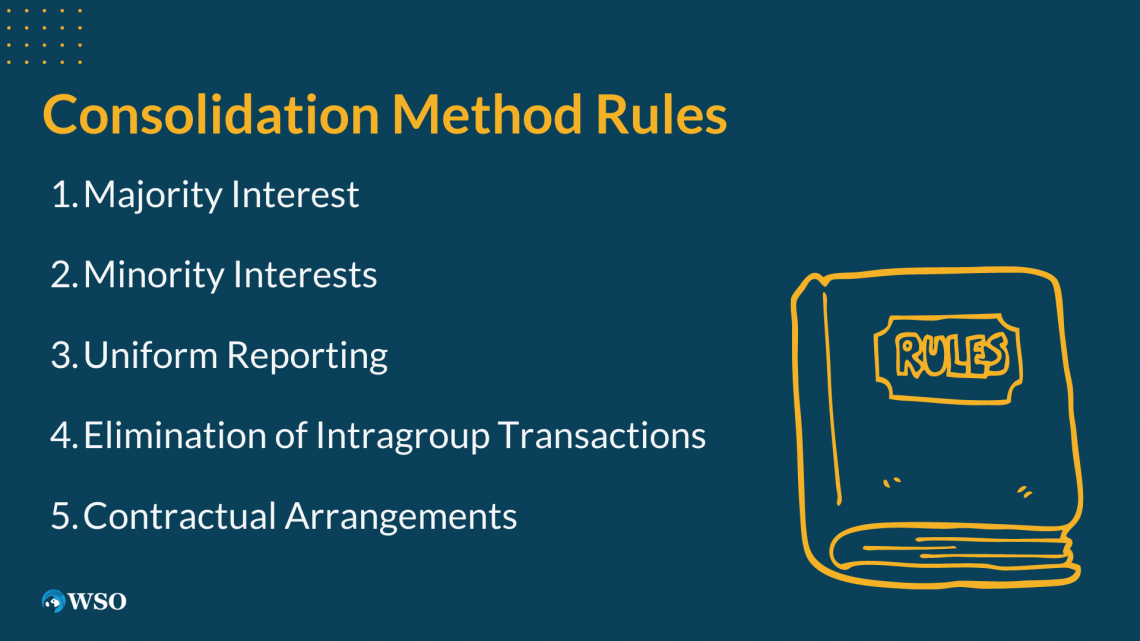
The consolidation approach has the following main rules:
1. Majority Interest
According to the general rule for consolidation, a firm must combine a subsidiary's financial statements if it holds a majority interest or more than 50.1% of the voting power in another company.
This implies that the parent firm has control over the subsidiary and the authority to make choices that impact how it does business.
2. Minority Interests
Non-controlling or minority interests must be disclosed before combining. These stand for the equity or shares of the subsidiary that the parent firm does not possess.
To indicate the ownership held by outside parties, minority interests are disclosed separately in the consolidated financial statements.
3. Uniform Reporting
The parent company's and the subsidiary's financial reporting statements should be created using the same accounting practices, principles, and reporting period. By doing this, the financial data of the combined group is presented consistently and comparably.
4. Elimination of Intragroup Transactions
Intragroup transactions are exchanges that occur inside a group of companies, including loans, dividends, sales, and acquisitions.
These transactions and the associated balances are deleted during unification to prevent duplicate counting and to provide an accurate view of the group's financials.
This makes sure that the consolidated financial accounts only include transactions from the outside world.
5. Contractual Arrangements
Consolidation may still be necessary even if the parent company does not own a majority stake in the subsidiary's stock if there are significant contractual agreements or other commercial arrangements between the two parties.
Consolidation must present a realistic and fair picture of the group's financial status since these agreements may give the parent firm authority or influence over the subsidiary's activities.
Note
The consolidation method of accounting kicks in when the investor effectively controls the investee or subsidiary, which frequently, but not always, presupposes the investor has at least 50.1% of the subsidiary's shares or voting rights.
How does the consolidation method work?
According to the consolidation method of accounting, the parent company's consolidated financial statements include the financial performance of all its subsidiary firms.
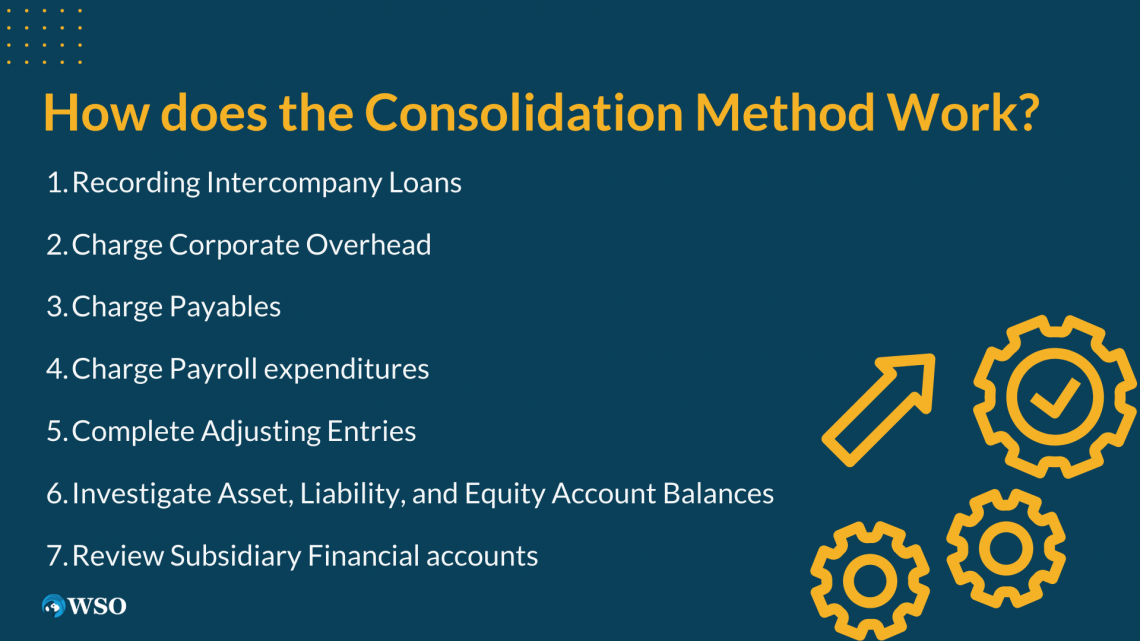
An outline of the consolidation accounting procedure is provided below:
- Recording Intercompany Loans: Intercompany loans from the subsidiaries to the parent company are documented if the parent company has combined the cash balances of the subsidiaries into an investment account. The parent business distributes interest income from consolidated investments to the subsidiaries.
- Charge Corporate Overhead: In the event that a parent company divides up its overhead expenses across its subsidiaries, the appropriate division is computed and charged to the respective subsidiaries.
- Charge Payables: If the parent business has a consolidated payables operation, confirm that all accounts payable recorded during the period have been charged to the appropriate subsidiaries.
- Charge Payroll expenditures: The distribution of payroll expenditures to subsidiaries is inspected and updated as appropriate if the parent business has a common paymaster system to pay employees across the organization.
- Complete Adjusting Entries: Adjustments are made at the corporate and subsidiary levels to accurately record revenue and cost transactions in the appropriate accounting period.
- Investigate Asset, Liability, and Equity Account Balances: The contents of asset, liability, and equity accounts for both subsidiaries and the parent business are reviewed and changed as necessary.
- Review Subsidiary Financial accounts: Each subsidiary's financial accounts are printed and reviewed, with any strange or inaccurate items being looked into and any required corrections being made.
These procedures ensure that the consolidation process is carried out properly by excluding intercompany transactions and providing a truthful and fair assessment of the financial status and performance of the merged group.
Note
Consolidated financial statements result in how the organization performs with its decision-makers.
Types of Consolidation Method
Parent firms and their subsidiaries fall into one of the three categories below, depending on the extent of parental company control.
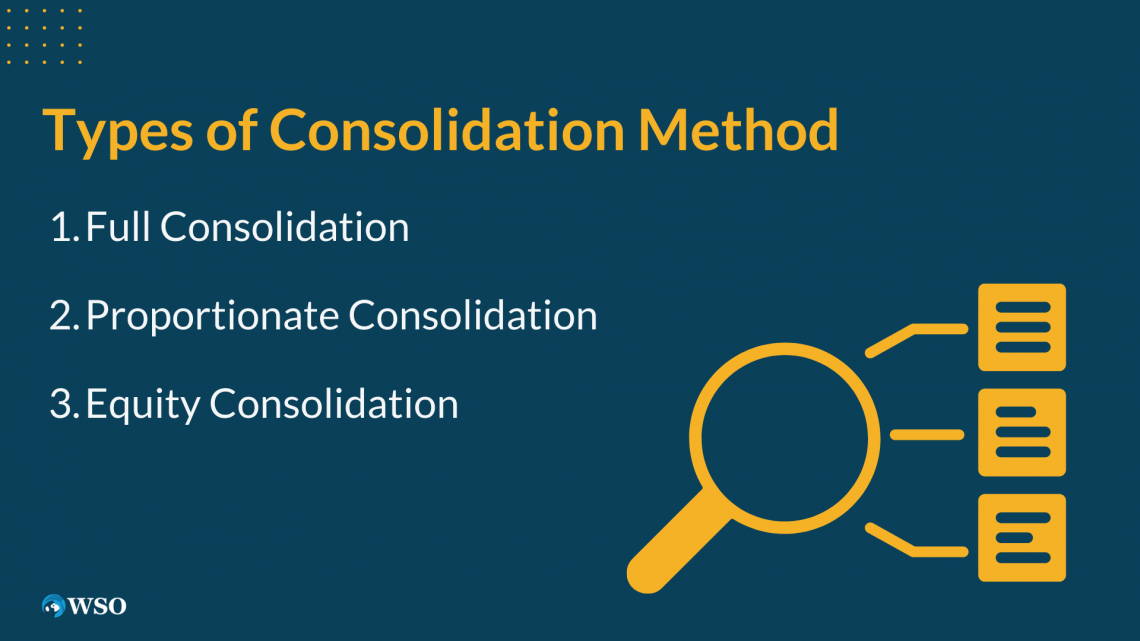
For your financial departments to submit reports in accordance with the consolidation criteria intended for your company and its branches, it is crucial to identify which category your business falls under.
1. Full Consolidation
The parent business holds a majority of the subsidiary in this consolidation accounting approach. As a result, the parent firm has total control over the reporting and accounting of the subsidiary.
2. Proportionate Consolidation
The percentage supplied by the parent business to the subsidiary is the proportion utilized to compile the financial reporting statements under this unification accounting technique.
Essentially, this strategy distributes an entity's assets, liabilities, equity, revenue, and costs in accordance with its participation in the endeavor. As a result, any parent-subsidiary business (regardless of investment percentage) can use this reporting approach.
Note
Proportional Consolidation is preferred because it produces more thorough and accurate results.
This strategy enables each party to assess the joint venture's operational efficacy, including factors like production costs and profit margins.
3. Equity Consolidation
The investor does not have complete control over the subsidiary under this consolidation accounting approach, but he or she does have substantial influence.
Equity consolidation is used for reporting when an investor has significant influence, which is usually defined as owning between 20% and 50% of the investor's voting shares.
This strategy is frequently utilized when one entity in a joint venture plainly has greater influence (than the other entity).
This strategy evaluates the earnings generated by investments in other businesses. If a firm owns more than 20% of another company's shares, it has substantial power over the other company and may exercise influence over it.
The original investment is recorded at cost, and adjustments are made quarterly based on the value at the end of the term.
Importance of Consolidation in Accounting
Consolidation has various impacts on the business and in accounting to reflect financial performance.
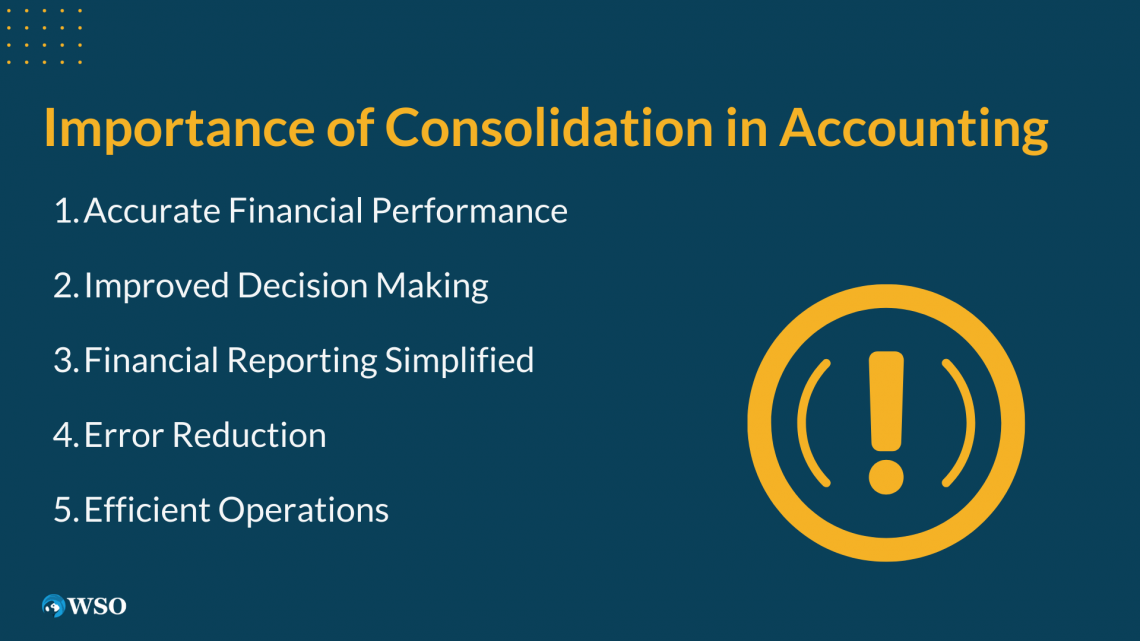
The following are the importance of consolidation in accounting:
1. Accurate Financial Performance
Consolidation guarantees that a group of firms' financial performance is appropriately portrayed. It gives a comprehensive perspective of the group's assets, liabilities, equity, and earnings, allowing management to evaluate its overall financial health and performance.
2. Improved Decision Making
Consolidated financial statements give decision-makers a clearer understanding of the group's overall financial status. It enables informed budgeting, strategic planning, and the identification of future difficulties or opportunities within the group of enterprises.
Decision-makers can recognize possibilities for growth, evaluate risks, and develop plans of action to improve the entire team's performance.
They can enter new markets, expand operations, or divest underperforming firms by carefully considering the financial performance of subsidiaries.
3. Financial Reporting Simplified
By unifying financial statements, the reporting process is streamlined and efficient. It removes the need to study several accounts from various businesses and consolidates data into a single report. This streamlines the financial reporting process and makes analysis easier.
4. Error Reduction
Consolidation minimizes the likelihood of accounting mistakes and misstatements. By consolidating things into a single entity, the danger of human mistakes, duplicate entries, and miscalculations is reduced.
This enhances the accuracy and dependability of financial reporting, lowering the possibility of costly errors. This also guarantees financial reporting consistency and lessens the possibility of errors brought on by various accounting treatments or interpretations.
5. Efficient Operations
Consolidation boosts operational efficiency by simplifying accounting processes. It saves time and effort on manual data entry, analysis, and reconciliation.
Consolidation enhances productivity and frees up resources for other value-added operations by automating intercompany transactions and removing redundant items.
Consolidated Financial Statements Issues
Businesses may find it difficult and complex to prepare consolidated financial statements. To give a cohesive image of a group's financial performance and situation, unification entails integrating the financial information of several businesses within the company.
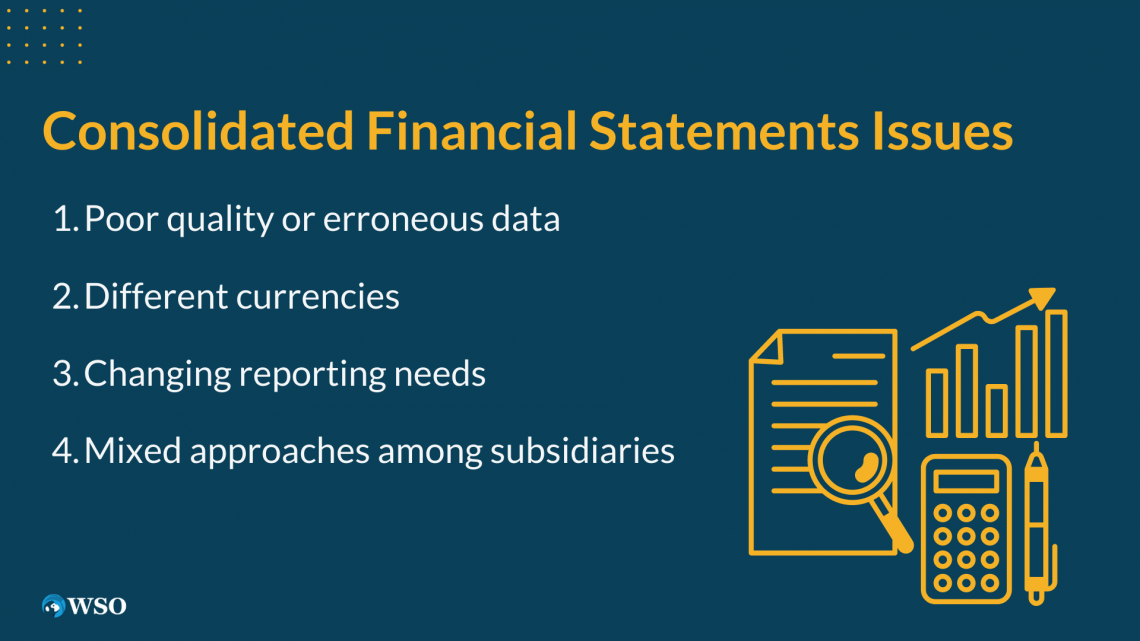
Consolidation is crucial for producing accurate and honest financial information, but it can also cause a number of problems.
1. Poor quality or erroneous data
When integrating financial accounts, data is sometimes manually entered by staff working across many firm sites and systems. Unfortunately, this increases the possibility of human mistakes.
If there are errors in the reports, it can significantly influence the overall picture of a company's success. As a result, processes may need to be implemented to keep records as accurate and dependable as feasible.
Note
Companies may reduce the possibility of input errors by creating their reports with financial consolidation software.
2. Different currencies
If subsidiaries are situated in different countries, the currency must be translated so that all data may be appropriately merged into the final report.
The complexity of currency translation is increased by changing exchange rates. Changes in exchange rates may have an effect on the reported financial numbers and may affect the group's financial performance and position.
Note
Translation profits or losses can arise from variations in exchange rates between the reporting date and the dates of the initial transactions.
3. Changing reporting needs
Accounting consolidation reporting rules and requirements are changed regularly. As a company grows, staying on top of process changes is critical to attaining best practices in merging.
4. Mixed approaches among subsidiaries
When divisions or subsidiaries create their reports using various methodologies or tools, problems might develop. This is why organizations should adopt a single-system strategy so that all subsidiaries have a standardized reporting mechanism.
Summary
Accounting consolidation is an essential technique that enables corporations to reflect a group of enterprises' financial performance correctly. It entails integrating the financial statements of subsidiary firms into the parent company's consolidated financial accounts.

By unifying financial information, managers may acquire insights into the group's overall financial health, identify possible difficulties or opportunities, and make educated budgeting and resource allocation decisions.
The consolidation Method simplifies financial reporting by presenting a consistent set of financial statements that results in reducing complexity and improves efficiency. It also aids in ensuring conformity with accounting standards and legal obligations.
Companies are frequently required to produce consolidated financial statements to stakeholders that result in demonstrating openness and providing accountability.
Accounting standards such as GAAP or IFRS aim to improve the consistency and fairness of financial reporting, improving the reported data's trust and dependability.
It reduces the financial reporting risk of errors or misstatements and provides the benefit of decision-making and compliance. It guarantees that financial statistics are not double-counted or inflated by removing intercompany transactions and balances.
This improves the consolidated financial statements' accuracy and reliability, giving stakeholders a more accurate view of the group's financial performance.









or Want to Sign up with your social account?